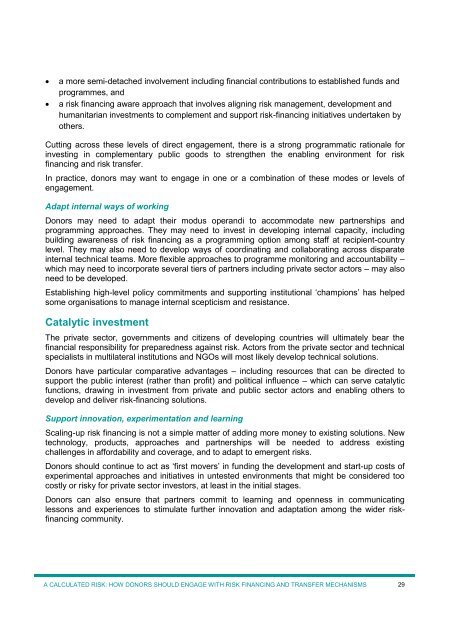k5q82a3
k5q82a3
k5q82a3
You also want an ePaper? Increase the reach of your titles
YUMPU automatically turns print PDFs into web optimized ePapers that Google loves.
a more semi-detached involvement including financial contributions to established funds and<br />
programmes, and<br />
a risk financing aware approach that involves aligning risk management, development and<br />
humanitarian investments to complement and support risk-financing initiatives undertaken by<br />
others.<br />
Cutting across these levels of direct engagement, there is a strong programmatic rationale for<br />
investing in complementary public goods to strengthen the enabling environment for risk<br />
financing and risk transfer.<br />
In practice, donors may want to engage in one or a combination of these modes or levels of<br />
engagement.<br />
Adapt internal ways of working<br />
Donors may need to adapt their modus operandi to accommodate new partnerships and<br />
programming approaches. They may need to invest in developing internal capacity, including<br />
building awareness of risk financing as a programming option among staff at recipient-country<br />
level. They may also need to develop ways of coordinating and collaborating across disparate<br />
internal technical teams. More flexible approaches to programme monitoring and accountability –<br />
which may need to incorporate several tiers of partners including private sector actors – may also<br />
need to be developed.<br />
Establishing high-level policy commitments and supporting institutional ‘champions’ has helped<br />
some organisations to manage internal scepticism and resistance.<br />
Catalytic investment<br />
The private sector, governments and citizens of developing countries will ultimately bear the<br />
financial responsibility for preparedness against risk. Actors from the private sector and technical<br />
specialists in multilateral institutions and NGOs will most likely develop technical solutions.<br />
Donors have particular comparative advantages – including resources that can be directed to<br />
support the public interest (rather than profit) and political influence – which can serve catalytic<br />
functions, drawing in investment from private and public sector actors and enabling others to<br />
develop and deliver risk-financing solutions.<br />
Support innovation, experimentation and learning<br />
Scaling-up risk financing is not a simple matter of adding more money to existing solutions. New<br />
technology, products, approaches and partnerships will be needed to address existing<br />
challenges in affordability and coverage, and to adapt to emergent risks.<br />
Donors should continue to act as ‘first movers’ in funding the development and start-up costs of<br />
experimental approaches and initiatives in untested environments that might be considered too<br />
costly or risky for private sector investors, at least in the initial stages.<br />
Donors can also ensure that partners commit to learning and openness in communicating<br />
lessons and experiences to stimulate further innovation and adaptation among the wider riskfinancing<br />
community.<br />
A CALCULATED RISK: HOW DONORS SHOULD ENGAGE WITH RISK FINANCING AND TRANSFER MECHANISMS<br />
29



